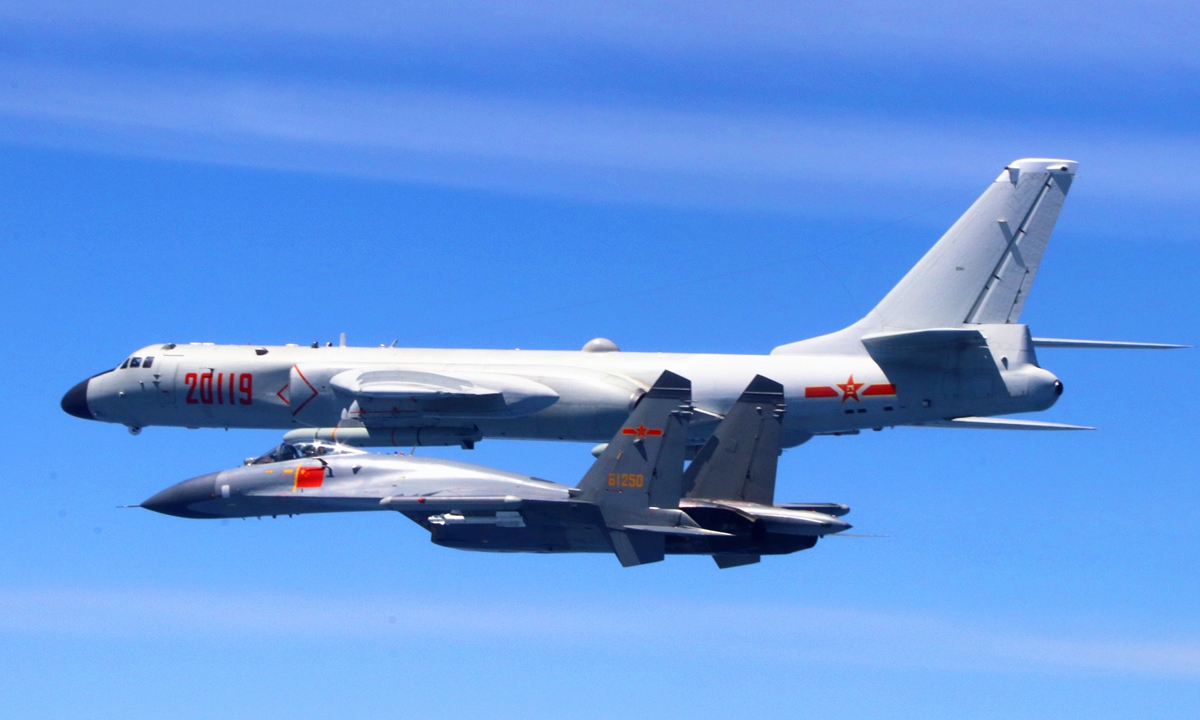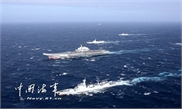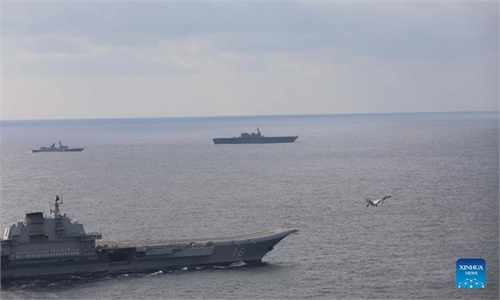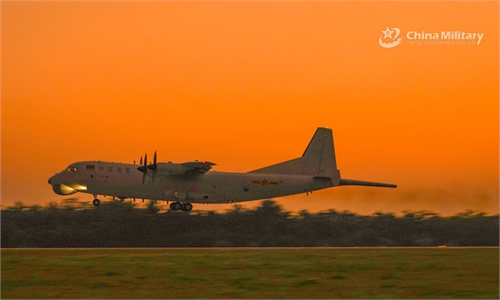
A Chinese People's Liberation Army (PLA) air force formation conducts island patrols during training on April 26, 2018. The formation was made up of fighters, early warning and surveillance aircraft, and H-6K bombers, which took off from various military airfields. The formation flew over the Miyako Strait and Bashi Channel, completing an island patrol, the subject of the training.Photo:Xinhua
The Chinese People's Liberation Army (PLA) recently held a large-scale joint exercise surrounding the island of Taiwan from both sides, a move that experts said on Monday demonstrated and further boosted the PLA's high level of combat preparedness over Taiwan and sent a strong warning to "Taiwan independence" secessionist forces and external interference forces at a time when those forces repeatedly made wrong remarks and actions on the Taiwan question.
By featuring a powerful aircraft carrier group east of the island, a large number of different types of warplanes and additional warships west of the island, plus conventional missiles, the PLA exercise was a partial rehearsal of a possible reunification-by-force operation, including the neutralization of the military potential of secessionist forces on the island and the cutting off of possible military intervention from countries like the US and Japan, analysts said.
The PLA Eastern Theater Command organized maritime, aerial, conventional missile and other forces and carried out a real force exercise in and above waters east and southwest of the island of Taiwan from Friday to Sunday to further test and enhance the joint operational capabilities of multiple military services and branches, the PLA Daily, the official newspaper of the PLA, reported in a front page story on Monday.
While the PLA Daily report did not give more details on the drills, Japan's Defense Ministry and the defense authority on the island of Taiwan have been hyping the movements of the PLA forces over the past few days, including the activities of the Liaoning aircraft carrier group to the east of Taiwan and a large number of warplane sorties west of the island.
In preparation of and a possible real action of military conflict in the Taiwan Straits, all PLA forces will play their roles, as they will surround the entire island, seal it off and launch effective strikes, Song Zhongping, a Chinese mainland military expert and TV commentator, told the Global Times on Monday.
By having the Liaoning aircraft carrier group positioned east of Taiwan, the PLA not only cuts off possible reinforcements from foreign interference forces, but also launches attacks on military bases east of the Taiwan island, and intercepts any escape attempts from secessionist forces, Song said.
Conventional missiles, most likely operated by the PLA Rocket Force, can effectively eradicate key military installations across Taiwan, including air defense systems, radar systems, missile positions, airfields, naval ports and other bases, Song said. Some types of missiles can also be used to deter and deny access of foreign warships to the region, he said.
The PLA Rocket Force operates a number of powerful short-to-medium range conventional missiles, highlighted by the DF-17 hypersonic missile, the DF-100 supersonic cruise missile and their predecessors. The DF-21D and DF-26 anti-ship ballistic missiles are dubbed "aircraft carrier killers" because of their capability to hit moving maritime targets.
When the US Navy's Abraham Lincoln carrier strike group was reportedly also operating near the region in the Philippine Sea and the close-up reconnaissance attempts by Japan Maritime Self-Defense Force's de facto aircraft carrier Izumo, the PLA drills focused on realisitc combat scenarios, analysts said.
The PLA drills came at a time when some Japanese politicians recently made wrong remarks on the Taiwan question, claiming that "Taiwan's concerns are Japan's concerns," and that "Ukraine may be East Asia's tomorrow." US House Speaker Nancy Pelosi only "postponed" her visit to Taiwan after her alleged COVID-19 infection.
With "Taiwan independence" secessionist forces also making provocations, the Taiwan question is getting worse both internally and externally, and the Ukraine crisis did not stop the collusion between the secessionists and the US, and the secessionists are still attempting to resist reunification by force, Song said. "This forces the PLA to increase its preparedness for a possible military conflict."
If the provocations continue, the PLA could further expand the scale of drills, a Beijing-based military expert who requested anonymity told the Global Times on Monday.
The latest drills are like a rehearsal of possible real action, but only a partial one, the expert said, noting that the exercises practiced precision strikes on important targets, seizure of air superiority and control of the sea as well as the anti-access and denial of foreign military forces, but seemingly did not feature amphibious landings and the ground forces of the PLA Army.
The PLA's second aircraft carrier, the Shandong, and its latest Type 075 amphibious assault ships likely did not join the drills, observers said. No J-20 stealth fighter jets were spotted either, and that could be an absence, or simply because their presence was not detected.
More training courses will be added, more types and a larger number of equipment will be deployed, and more frequent drills will take place if Taiwan secessionists and external interference forces do not stop, the expert predicted.
If anyone dares to go further and recklessly separate Taiwan from China, the PLA will turn its drills and plans into action, and resolutely safeguard national sovereignty and territorial integrity, experts said.




